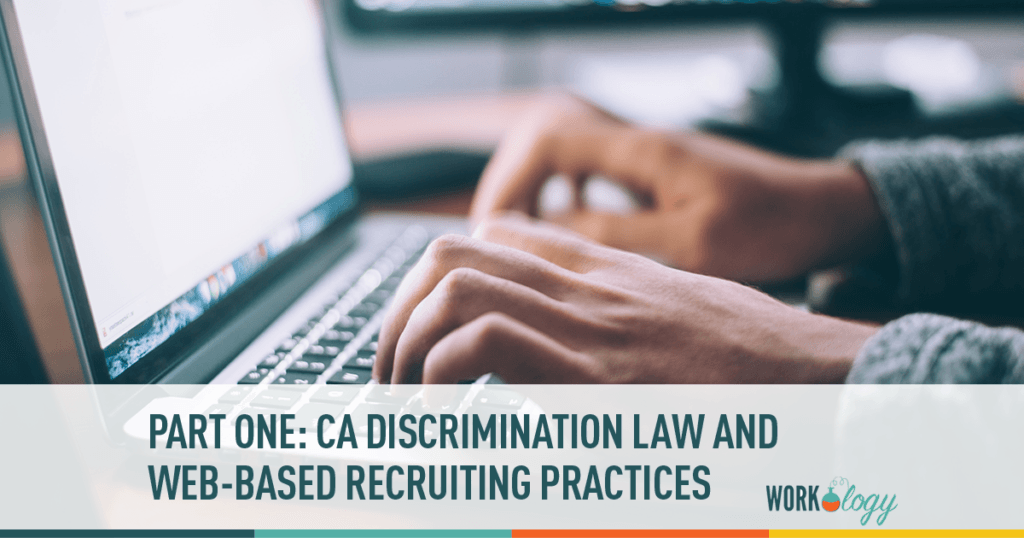Mary Wright explains the HR pitfalls in the relationship between California discrimination law and web-based recruiting practices. Join us for Part Two later this week when she puts the two pieces together. Part one discusses discrimination laws in California.
By now, every HR professional knows that it is a violation of civil law to discriminate against an employee or candidate because of their membership in a group identified as protected by state or federal civil rights laws. This article will discuss how HR folks – acting as in-house recruiters – can get themselves into hot water by not understanding how discrimination law applies to web-based recruiting practices.
The California law against discrimination, harassment and retaliation is found in the Fair Employment & Housing Act, California Government Code §12900, et seq. (“FEHA”) and the California Code of Regulations, 2 Cal. Code Regs. §7285, et seq. (“Regulations”).
Who is protected?
The FEHA prohibits discrimination and harassment on the basis of race, religious creed, color, national origin, ancestry, physical or mental disability, medical condition, genetic information, marital status, sex (including pregnancy, childbirth, breastfeeding or related medical conditions), gender, gender identity, gender expression, veteran status, age and sexual orientation (“Protected Category”). It also prohibits retaliation against an employee or candidate for protesting violation of the FEHA or participation in an investigation relating to an alleged violation.
What are HR’s obligations?
For the purpose of this article on recruiting, it is most important that HR understand that an employer may not discriminate against an applicant for employment on the basis of their membership in a Protected Category in the terms or conditions of employment.
How does California law define recruitment and recruiting activities?
The state agency enforcing the FEHA is called the Department of Fair Employment and Housing (“DFEH”). The DFEH follows the FEHA and Regulations, and, additionally, publishes and follows its own internal guidelines found on the Internet at http://www.dfeh.ca.gov/
The DFEH and California lawmakers have determined that recruiting is an activity that impacts the terms and conditions of employment The Regulations define recruiting as “the practice of any employer …that has the purpose or effect of [1] informing any individual about an employment opportunity, or [2] assisting an individual to apply for employment, as an activity leading to employment, membership in a labor organization, acceptance in an apprenticeship training program or [3] referral by an employment agency.” 2 Cal. Code Regs. §7287.2(a).
“To Inform”
Activities that “inform” applicants of openings and opportunities may include writing and placing classified ads, internal job postings, openings posted on the internet or advertised in the newspaper or other hard copy communications. Information may be provided through job fairs, and college or high school recruitment efforts. Farmer, Douglas J., California employment law: the complete survival guide to doing business in California, p. 68, Oakland, CA: Employment Law Publishers, 2013.
“To Assist”
Activities that “assist” applicants in applying for the position may include those performed by “employment or job placement agencies, outplacement firms, HR departments, hiring halls, college placement offices, temporary staffing firs or other entities assisting individuals in the employment application process.” Id. at 69.
To Refer”
“Referrals” include those that come from staffing or temporary agencies, union hiring lists, websites that refer job applicants, and applicants of recruiters or other third parties. Id.
The 2 Types of Discrimination
There are two types of discrimination prohibited by the FEHA: Disparate Treatment Discrimination and Disparate Impact Discrimination. Cal. Govt. Code §12940.
Disparate Treatment
This means discrimination in how an individual is treated because of their membership in a Protected Category; i.e., the refusal to hire an African American candidate is motivated by prejudice against racial minorities.
Disparate Impact
Disparate impact discrimination occurs when the employer has a policy that appears neutral on its face but which (a) is not genuinely mandated by any business need; and (b) has a tendency to exclude individuals belonging to a Protected Category. For instance, requiring candidates to apply only through an online job board, company listing, or other Internet site, could, in fact, eliminate or place at a disadvantage candidates who do not have ready access to a computer or the Internet. Computer and Internet access is frequently dictated by socio-economics, and a recruitment policy that dictates electronic access – a policy appearing neutral on its face — may cause a disproportionate adverse impact on minority candidates.
Other types of facially neutral policies that may disproportionately impact specific groups are:
- word of mouth recruiting,
- recruitment of family members,
- requiring or prohibiting “walk-in” applications,
- recruiting only through specific schools,
- recruitment through staffing agencies or union halls with geographically limited applicant pools, or
- limiting pools to specific geographic areas, (redlining the applicant pool),
- requiring unnecessary skills, education or experience, and
- recruiting from other employers with similar limitations.
Farmer, Douglas J., California employment law: the complete survival guide to doing business in California, p. 71, Oakland, CA: Employment Law Publishers, 2013.
Find more about this topic from the Employment Law Publishers.









